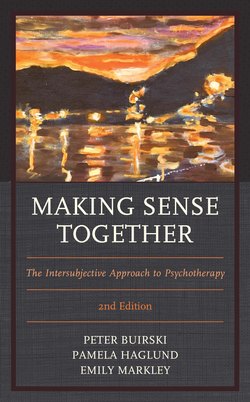Читать книгу Making Sense Together - Peter Buirski - Страница 4
На сайте Литреса книга снята с продажи.
ОглавлениеPreface
First Edition
This book is intended for students of the psychotherapeutic process and particularly those interested in the intersubjective perspective. In our own professional development, we have followed many paths that have led us to the point of writing this book. We have been patients in psychotherapy and psychoanalysis, graduates of psychoanalytic training institutes, and teachers of psychoanalytic theory and practice to graduate psychology students and candidates in analytic training.
We were both first exposed to psychoanalytic theory and treatment from the perspective of ego psychology. Over the years, our thinking and practice have evolved. We have found that arriving at a theory of practice has been an ongoing, long-term evolutionary process. Like being a patient in psychotherapy, becoming a psychotherapist is a highly personal experience of deepening self-awareness. There are times of anxiety, dread, and self-doubt, as well as times of hope, confidence, and joy in the mutuality of the endeavor. Growth occurs slowly, incrementally, and imperceptibly, over long periods of time.
Our experience is that becoming a psychotherapist is indeed an unfolding process of lifelong learning, like becoming an adult. There is no quick, short-term strategy to reach a final, fully formed developmental stage. In raising children, each unique parent and child pair emerges from the ongoing, mutually influencing relationship that exists within a complex context of a given cultural, historical, and socioeconomic climate. So it is with evolving as a psychotherapist. Imagine if parents and children functioned like a managed-care family: “You have ten years to grow up and that’s it.” Unfortunately, the context in which we currently work and write places this kind of demand on therapists and patients.
Our original training was in ego psychology, and we have grown into the intersubjectivity theory over many years. Our theoretical evolution was influenced more by a dawning realization that our practice had changed in ways no longer consistent with our original theory. Over time, we found ourselves more focused on the quality of our relationship with our patients. More and more, it seemed that what patients experienced as most helpful was not insight, but the accepting and affirming nature of the relationship that had been constructed. In fact, we realized that we could remember very few of the interpretations our analysts gave us. When we reflected on what was helpful in our own treatments, what stood out was some aspect of personal engagement with our analysts.
With intersubjectivity theory, we have found a sound theoretical approach that matches the ways we feel comfortable practicing. It makes sense to us, and we hope it will make sense to the reader.
Second Edition
Even though the first edition of this book was written twenty years ago, I still feel pleased with the book that Pam Haglund, PsyD, and I wrote. However, over the past twenty-eight years, my colleague Lynn Rosdal, PsyD, and I have supervised the clinical work of more than three hundred graduate students in clinical psychology at the Graduate School of Professional Psychology at the University of Denver in yearlong beginning psychotherapy seminars. I have also supervised advanced students in group supervision.
In this second edition, Emily Markley, PsyD, and I have tried to convey the challenges and gratifications of teaching the practice of the intersubjective perspective. Together, we have coauthored chapter 1: “Overview”; Chapter 9: “Listening and Responding Intersubjectively”; and Chapter 10: “Co-constructing a Developmental Narrative.” I have also had the rewarding experience of teaching case conference to psychoanalytic candidates at the Denver Institute for Psychoanalysis, and I have taught and supervised Chinese mental health professionals both online and in person. While much of what I have learned is based on my own clinical practice, and teaching and supervising early-stage clinicians, it is my hope that experienced clinicians, particularly those engaged in teaching or supervising, will find what Markley and I have written here to be useful to them.
Finally, it is important to note that becoming a psychotherapist is a lifelong learning endeavor. We are writing this second edition because we have grown and become better at practicing intersubjectively over the years. Unlike other professions or occupations, we psychotherapists are so fortunate to be in a profession where we don’t remain set in our ways but continue to evolve and grow.
